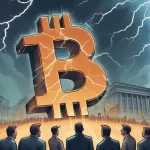Ripple’s $1B XRP Deal for GTreasury Targets $120T Corporate Treasury Market

Ripple’s $1 Billion XRP Acquisition of GTreasury Aims for $120 Trillion Corporate Treasury Market
Ripple has made a seismic move in the blockchain space, acquiring GTreasury, a long-standing treasury management solutions provider, for $1 billion in XRP. This deal, announced on Thursday, is a calculated strike at the colossal $120 trillion corporate treasury market, blending traditional finance with crypto innovation to overhaul how global corporations handle money.
- Ripple buys GTreasury for $1 billion in XRP, targeting corporate treasury.
- Aims to disrupt a $120 trillion market with blockchain payment solutions.
- Marks Ripple’s third major acquisition in 2025, pushing into TradFi.
The Deal Breakdown: A Billion in XRP
Ripple, a titan in blockchain-based payments, has long been obsessed with bridging the clunky world of traditional finance (often dubbed TradFi) with the speed and transparency of decentralized tech. Their native cryptocurrency, XRP, is built for lightning-fast, low-cost cross-border transactions—a far cry from the sluggish, fee-laden systems like SWIFT that dominate global finance today. For those new to the space, XRP acts as a digital bridge currency on Ripple’s network, RippleNet, facilitating near-instant settlements without the bureaucratic red tape.
Enter GTreasury, a 40-year veteran in treasury management. This isn’t some obscure startup; it’s a trusted name among Fortune 500 companies and global enterprises, providing tools for cash forecasting, risk management, and regulatory compliance. Corporate treasury, in simple terms, is the financial engine room of big business—managing billions in cash flows, ensuring liquidity for daily operations, and handling payments to suppliers across borders. It’s a slow, often inefficient beast, ripe for disruption. Ripple’s $1 billion bet, paid entirely in XRP, as detailed in this major acquisition announcement, is about embedding blockchain into this machine to enable real-time cross-border settlements, slashing delays from days to seconds. Picture a multinational corporation wiring $50 million to a supplier overseas without waiting three days for clearance—that’s the shiny promise here.
Ripple’s Vision: Fixing a Broken System
Brad Garlinghouse, Ripple’s CEO and a relentless critic of outdated financial plumbing, laid out the stakes with brutal clarity.
“For too long, money has been stuck in slow, outdated payments systems and infrastructure, causing unnecessary delays, high costs, and roadblocks to entering new markets—problems that blockchain technologies are ideally suited to solve.”
He took to social media to hammer the point home, posting on X:
“Today, Ripple is breaking into the $120T corporate treasury payments market with the $1B acquisition of GTreasury. The past few years have reminded this industry why payments, first and foremost, is THE primary use case for crypto and blockchain.”
GTreasury’s CEO, Renaat Ver Eecke, echoed the enthusiasm, framing the merger as a game-changer for corporate finance.
“We have focused on providing the most compliant and feature-rich solutions to corporations around the globe. Now, by joining Ripple, we are accelerating our vision from managing capital to activating it.”
The vision is seductive: corporations with billions in “trapped capital”—cash stuck in slow systems or siloed accounts—could unlock that liquidity with blockchain, moving money instantly and even earning returns on idle funds. Ripple’s not stopping at payments, though. They’ve got plans to route spare corporate cash into the global repo market, a short-term lending space where firms “park” extra funds overnight for small returns. Think of it as a financial parking lot for unused cash. Using Hidden Road, a prime brokerage firm acquired earlier in 2025, Ripple aims to make this process faster and cheaper, cutting out bloated intermediaries.
A 2025 Blitz: Building a Crypto-Finance Empire
This isn’t a one-off stunt for Ripple. The GTreasury deal is their third major acquisition this year, following Hidden Road and Rail, a stablecoin infrastructure platform. Together, these moves paint a picture of a company hell-bent on creating a full-stack crypto-financial ecosystem for enterprises. Rail, for instance, hints at tokenized corporate assets or stablecoin tools to shield treasurers from crypto’s wild price swings—crucial for risk-averse CFOs. Hidden Road, meanwhile, targets liquidity management, a sore spot for corporations with cash locked in inefficient cycles.
Compare this to other players in the blockchain payments game. Stellar (XLM), for instance, has chased similar cross-border goals with partnerships like IBM, leveraging an open-source ethos and less regulatory heat. Ethereum-based enterprise solutions, backed by heavyweights like ConsenSys, offer smart contract flexibility for complex financial agreements, something XRP doesn’t prioritize. But Ripple’s edge is speed and focus—RippleNet is engineered for raw transaction efficiency, not programmability. They’re betting that corporate treasuries care more about slashing settlement times than coding bespoke contracts. Whether that gamble pays off is anyone’s guess, but Ripple’s aggressive spree shows they’re not playing for second place in enterprise blockchain solutions.
Risks and Roadblocks: A Regulatory Minefield
Here’s where we flip the coin and stare at the uglier side. Paying $1 billion in XRP is a bold middle finger to skeptics, signaling unshakable confidence in the token’s utility as a medium of exchange. But it also paints a target on Ripple’s back for regulators. Since 2020, Ripple has been embroiled in a $1.3 billion lawsuit with the U.S. Securities and Exchange Commission (SEC), which claims XRP is an unregistered security. A partial win in 2023 clarified that retail sales of XRP aren’t securities, but institutional transactions—like, say, a $1 billion acquisition—remain under a legal cloud. The GTreasury deal, slated to close in a few months, hinges on regulatory approval. If the SEC or global frameworks like the EU’s MiCA decide to play hardball, this could stall or even derail the merger. Expect bureaucratic tantrums louder than a kid denied dessert—Ripple’s got to tread lightly.
Then there’s the tech hurdle. Melding blockchain with GTreasury’s decades-old systems isn’t like updating an app—it’s a slog. Many corporate treasurers cling to familiar tools, even outdated ones like Excel, because stability trumps innovation in their world. Resistance to change could be fierce. Add to that privacy concerns; blockchain’s inherent transparency, even on private networks like RippleNet, might spook firms terrified of exposing financial data. Scalability is another beast—handling trillions in corporate flows isn’t the same as settling crypto trades on a quiet day. Ripple must prove they can manage this without imploding, or they risk tarnishing blockchain’s reputation in TradFi. History offers warnings: early Ethereum enterprise projects often stumbled on scalability and cost, leaving skeptical corporates burned. Ripple’s got to dodge that fate.
What It Means for Crypto and Bitcoin Fans
If Ripple nails this, the impact could ripple—pun intended—beyond corporate treasury into sectors like supply chain finance or insurance, proving blockchain can solve real-world pain points. For Bitcoin maximalists like myself, who see BTC as the ultimate decentralized store of value and a middle finger to fiat insanity, Ripple’s corporate cozying might seem like selling out. Bitcoin’s power is in censorship resistance and individual freedom—it doesn’t need boardroom buy-in to change the world. But I’ll grudgingly concede that Ripple’s path, while different, serves the broader revolution. While BTC empowers you to escape fiat control, XRP aims to make fiat systems less painful. Two roads, one destination: a future where centralized gatekeepers lose their grip.
That said, let’s kill the hype before it festers. The crypto graveyard is packed with projects that overpromised and underdelivered on enterprise integration. Ripple has a track record of pushing boundaries, but execution is everything. And to the shills already screaming about XRP blasting to $100 off this news—cut the nonsense. Price speculation tied to vague “deals” is usually hot air. Look at past XRP pumps on partnership rumors; they often crashed when reality hit. Focus on utility, not moonshot daydreams. We’re here for facts, not fairy tales.
Key Takeaways and Questions to Ponder
- What does Ripple’s acquisition of GTreasury mean for blockchain in corporate finance?
It could fast-track blockchain adoption in a $120 trillion market, showcasing real-time payments and liquidity solutions—if Ripple delivers on the tech. - Is using $1 billion in XRP a risky play amid regulatory uncertainty?
Damn right it is. The SEC’s ongoing battle with Ripple over XRP’s status could snag this deal, despite the confidence it projects. - Can Ripple integrate blockchain with GTreasury’s legacy systems?
It’s a tough nut to crack. Technical challenges and corporate resistance to change could stall progress, though success would be a landmark win. - How does this fit into Ripple’s 2025 strategy for crypto payments?
It’s a core piece of their push to dominate enterprise blockchain, alongside acquisitions like Hidden Road and Rail, building a robust financial toolkit. - Why should Bitcoin enthusiasts care about Ripple’s TradFi moves?
Even if BTC’s ethos is pure decentralization, Ripple’s success could normalize blockchain tech, smoothing the path for wider crypto acceptance.
Zooming out, Ripple’s gamble on GTreasury is a gutsy bet on the future of money. It’s a push to activate capital in the digital economy, as Ver Eecke put it, and a potential proof of concept for blockchain’s killer app: payments. But the path is littered with regulatory traps and technical potholes. With three big acquisitions in 2025, Ripple’s riding a wave of momentum, yet only time will tell if this is genius or overreach. For anyone cheering crypto’s mission to upend the status quo, this is a saga worth watching—just don’t expect overnight miracles. We’re reporting the raw truth, not peddling pipe dreams. Stay sharp out there.



